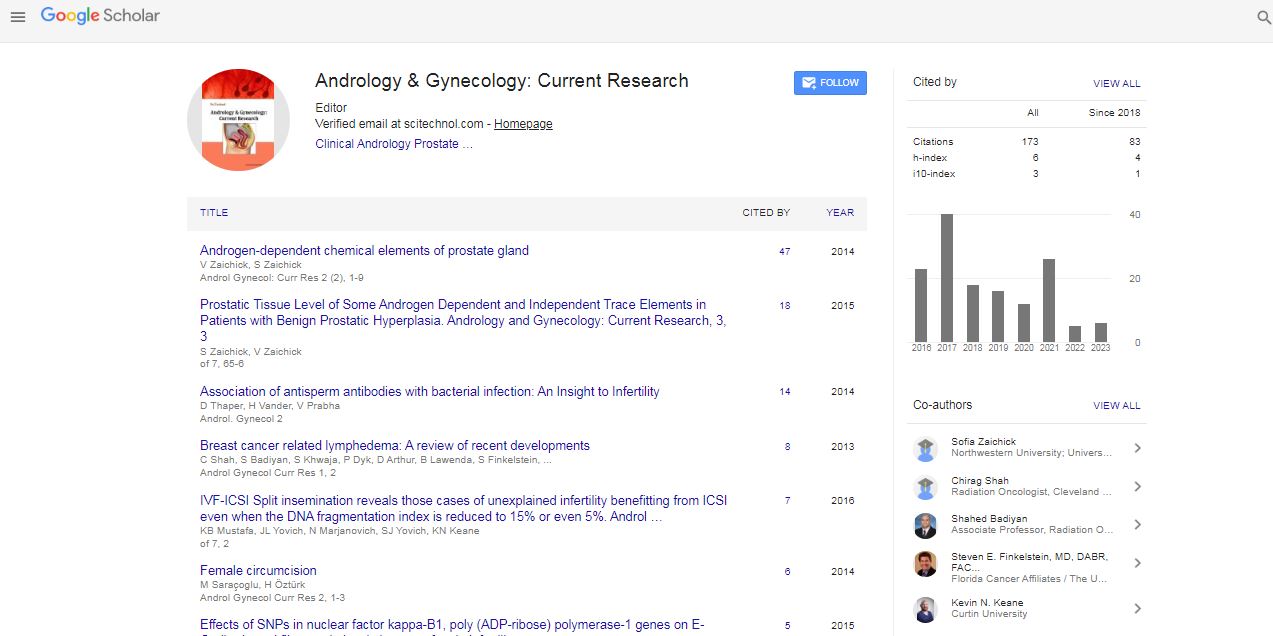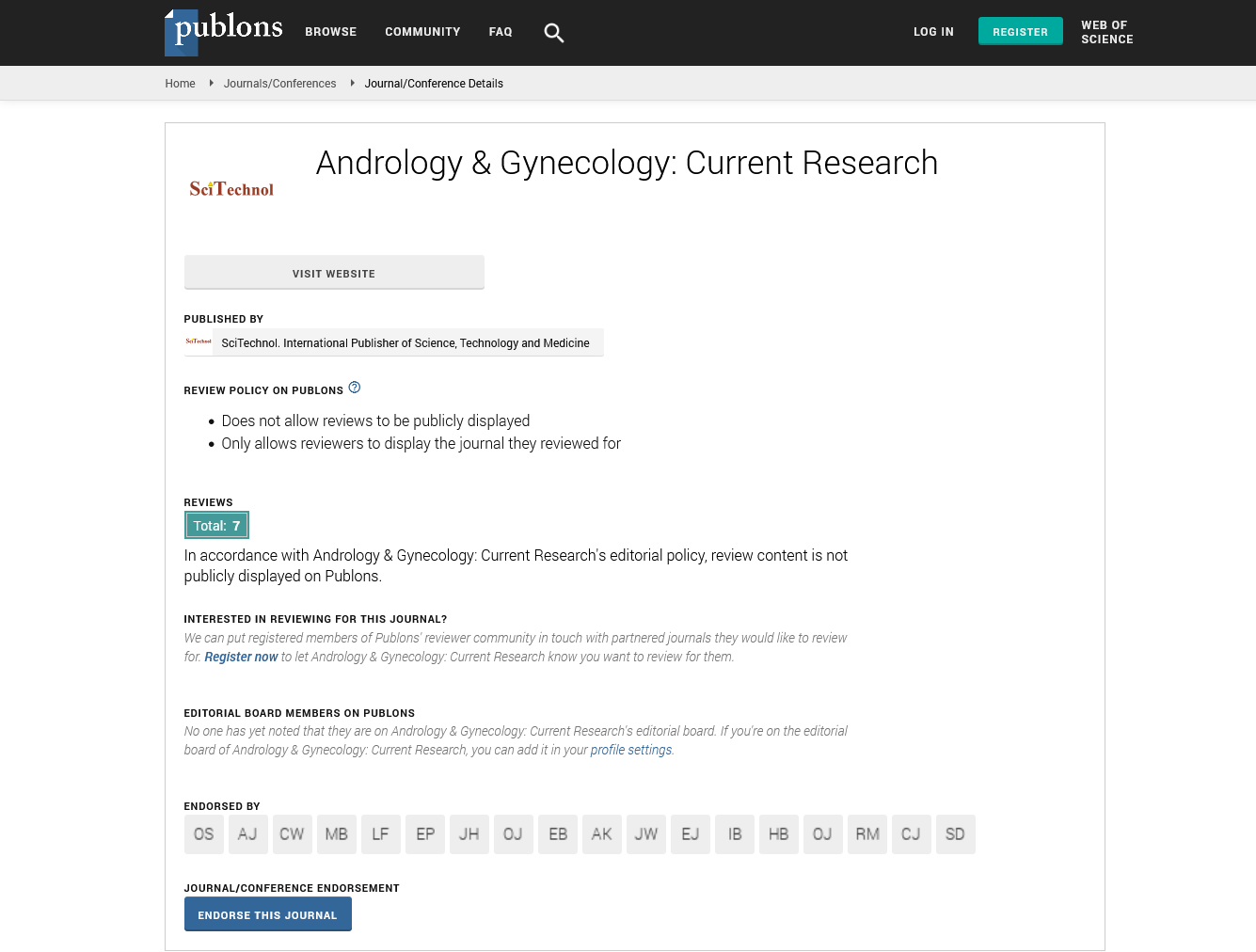Research Article, Androl Gynecol Vol: 7 Issue: 2
Post Vasectomy Semen Analysis Factors Predicting Compliance
Grant S Johnson1,2*, Greg Andros3 and James Siegert1,4
Department of Forestry and Biodiversity, Tripura University, Suryamaninagar, Agartala, India
*Corresponding Author : Grant S Johnson
Franciscan Health, 20201 South Crawford Avenue, Olympia Fields, IL 60464, USA
E-mail: Gjohnson71@midwestern.edu
Received: May 28, 2019 Accepted: June 19, 2019 Published: June 27, 2019
Citation: Johnson G, Andros G, Siegert J (2018) Post Vasectomy Semen Analysis-Factors Predicting Compliance. Androl Gynecol: Curr Res 7:1.
Abstract
Objective: To determine the impact of patient demographics, health care related factors, and financial factors on Post-Vasectomy Semen Analysis compliance (PVSA). Methods: A retrospective review was performed of 248 men who underwent the first-time vasectomy between January 2008 through March 2016. Baseline demographic factors were collected and analyzed according to PVSA compliance. Chi-squared analysis was used to evaluate the predictive value of these factors for PVSA return. Results: Forty-two percent of men returned at least one postvasectomy semen analysis while twenty percent returned two PVSA collections. Compared to non-compliant men, patients who returned at least one PVSA were more likely to have independent predictive factors of smaller family size (p<0.0003), older age (p<0.002) and Caucasian race (p<0.03). Marital status, tobacco use, alcohol use, comorbidities, body mass index, insurance, occupation, and direct patient expenses were not significant factors. Conclusion: Men older than 38 years, those with smaller family size, and those of Caucasian ethnicity were more likely to return at least one PVSA. Compliance for PVSA return has remained dismal despite relaxed semen analysis protocols when compared to historical recommendations. Further research is needed to determine additional factors and improve compliance with a postvasectomy semen analysis. All men should be encouraged and counseled on the importance of PVSA compliance for determining successful versus failed vasectomy to ensure future family planning.
Keywords: Sterilization; Semen analysis; Guideline; Vasectomy; Contraception
Introduction
Vasectomy continues to be one of the primary contraceptive methods for couples given its high safety profile and efficacy in achieving sterility. Following a vasectomy, a small number of sperm can remain in the distal portions of the male reproductive tract. Therefore, men are commonly counseled to perform 10-20 ejaculations to clear residual sperm followed by providing a postvasectomy semen specimen for confirmation of sperm clearance. Unfortunately, it is well documented that Post-Vasectomy Semen Analysis (PVSA) compliance rates range from 55%-71% in North America, raising potential medicolegal implications [1-3]. The contributing factors to PVSA noncompliance are poorly defined.
It has been suggested that timing and number of post-vasectomy semen analysis required for clearance as well as lack of close follow up, negatively impact compliance rates [4-6]. Historically, the American Urological Association (AUA) recommended stringent criteria defined as two successive centrifuged azoospermic semen analysis samples. In 2012, the AUA formulated consensus guidelines regarding vasectomy including the recommendation for obtaining at one negative post-vasectomy semen analyses (PVSA) prior to cessation of other contraceptive methods, with PVSA defined as one well mixed, uncentrifuged semen specimen with azoospermia or rare non motile sperm (<100,000 non motile sperm/ml) [7]. However, despite the relaxed criteria for only one required PVSA, compliance rates have remained low. Given the multifactorial nature of this issue, we evaluated the potential impact of patient demographics, financial, and health-care related factors on PVSA completion.
Materials and Methods
We retrospectively reviewed our outpatient clinic database of 248 men who underwent the first-time vasectomy between January 1, 2008, through March 18, 2016, by one of nine board-certified urologists [8]. The vasectomy procedure was performed in the outpatient office setting with local anesthesia. Standardized written and verbal instructions were given to all patients for PVSA return in approximately 3 months (or after 10-20 ejaculations) to one of three local hospital laboratories. Specimen cups are sent with the men following their procedure and all were instructed to utilize alternative methods of contraception until sterility could be confirmed. Follow up appointments were not made for patients. Following publication in May 2012 of the updated AUA guidelines on vasectomy, the number of PVSAs recommended to patients declined to one, however, no other protocol changes were made.
Results
Forty-two percent of men (103/248) returned at least one postvasectomy semen analysis while 19.7% returned two PVSA collections. Baseline demographics demonstrated an average age of 38 years, mostly Caucasian (77%) skilled workers (71%) with an average family size of 2.5 kids (Median 2 kids). Average time to PVSA return was 14.5 weeks for the 103 compliant men. Compared to non-compliant men, patients who returned at least one PVSA (Table 1), were more likely to have independent predictive factors of smaller family size (two or fewer kids, p<0.0003), greater age (greater than 38 years old at vasectomy, p<0.002) and Caucasian race (p<0.03). Marital status, tobacco use, alcohol use, comorbidities, BMI, insurance, occupation, and direct patient expenses were not significant factors.
| No PVSA | Any PVSA | p-value | |
|---|---|---|---|
| N=145 | N=103 | ||
| Age >38 years | 41% | 60% | 0.002 |
| Tobacco use | 68% | 69% | 0.347 |
| Alcohol use | 72% | 66% | 0.28 |
| Married | 88% | 86% | 0.785 |
| Family size >2 | 53% | 29% | 0.0003 |
| Caucasian | 72% | 84% | 0.03 |
| Skilled Occupation | 71% | 76% | 0.385 |
| Comorbidities present | 37% | 38% | 0.92 |
| Obesity (BMI>30) | 33% | 32% | 0.93 |
| Blue Cross Blue Shield Insurance | 67% | 69% | 0.82 |
| Out of pocket expense >30$ | 44% | 55% | 0.11 |
Note: Proportion of noncompliant (No PVSA) vs. compliant (Any PVSA) men with demographic and health related factors. Analysis for differences using chi squared analysis (p<0.05=significance)
Discussion
Poor compliance with post-vasectomy semen analysis is a widespread clinical challenge for urologists and is likely multifactorial with clinical, psychosocial and economic forces involved. Our overall compliance rate of 42% for the return of one PVSA is low compared to published data (55%-71%) [1-3].
The ability to predict which men are at high risk for noncompliance with post-vasectomy recommendations, specifically semen analysis return, has been difficult to quantify. In our data, those men who were 38 years or older or who had smaller family size had significantly better compliance with PVSA return. We suspect that these men wanted to ensure occlusive success secondary to established families and occupations, however further evaluation with a validated questionnaire or personal interview would be needed to determine potential motives.
There was a significant difference in compliance when comparing Caucasian to non-Caucasian race (p>0.03), which may represent a socioeconomic, cultural and/or geographical difference in the perspective of PVSA compliance and/or of vasectomy in general, but this is difficult to speculate and requires further evaluation.
Our analysis expands on previous studies evaluating for noncompliance factors. Smucker et al. examined several factors for PVSA noncompliance in 141 men sent post vasectomy questionnaires [4]. They found that the majority of respondents were embarrassed about having to return a semen sample (55%). For those noncompliant men, “inconvenience, embarrassment, forgetfulness, or certainty of sterility” was cited as the most common reasons for their noncompliance. Interestingly, 28% of men in their study responded that they do not remember receiving PVSA counseling. Sheykin et al. examined socioeconomic factors of marital status, age, family size, level of education, and smoking history and found that, like our study, those men with larger family size were more likely to be noncompliant with PVSA return [9]. Those with smoking history and lower educational level also had decreased compliance. They saw no difference in age or marital status. Our analysis included additional clinical factors such as overall comorbidities, BMI, and alcohol use as well as financial factors including occupation, insurance type, and out of pocket costs. These factors did not show statistical significance. Limitations exist including the retrospective nature of data collection and occasional incomplete or unavailable data (1.2% of the database). Our results cannot be extrapolated to all socioeconomic groups as only three men were uninsured and the majority having private insurance policies.
In addition to standardized pre-procedure counseling regarding semen analysis return, attempts to improve compliance have centered around decreasing the number of PVSAs required for clearance and decreasing the time until first PVSA testing. Badrakumar et al. recommend one semen analysis at 3 months given this group was more compliant at PVSA return than those who were asked to return two samples at 3 and 4 months. The rate of azoospermia was not significantly different [5]. The 2012 AUA guidelines subsequently decreased requirements for post-vasectomy semen analysis to one. Dhar et al. prospectively evaluated the impact of scheduled followup appointments following vasectomy demonstrating improved compliance with PVSA return in the study group [6]. Another strategy is to utilize office-based Electronic Medical Record (EMR) database systems to automatically trigger patient reminders to be sent via email or postal mail. These efforts seek to decrease the logistical factors that potentially contribute to noncompliance. The 2012 American Urological Association vasectomy guidelines have the potential to decrease the number of post-vasectomy semen analysis required to ensure sterility, therefore leading to improved compliance rates. The projected impact of these guidelines has been evaluated in the literature with significant improvement in sterility rates, avoidance of unnecessary repeat vasectomies and cost savings [10,11].
Conclusion
Our research indicates three characteristics of men more likely to return at least one PVSA; men older than 38 years, those with smaller family size, and those of Caucasian ethnicity. Indeed, compliance for PVSA return has remained dismal even despite relaxed semen analysis protocols when compared to historical recommendations. Further research is needed to determine additional factors and improve compliance with a post-vasectomy semen analysis. All men should be encouraged and counseled on the importance of PVSA compliance for determining successful versus failed vasectomy to ensure future family planning.
References
- Chawla A, Bowles B, Zini A (2004) Vasectomy follow-up: Clinical significance of rare nonmotile sperm in postoperative semen analysis. Urol 64: 1212.
- Belker AM, Sexter MS, Sweitzer SJ, Raff MJ (1990) The high rate of noncompliance for post-vasectomy semen examination: Medical and legal considerations. J Urol 144: 284-286.
- Maatman TJ, Aldrin L, Carothers GG (1997) Patient noncompliance after vasectomy. Fertil Steril 68: 552-555.
- Smucker DR, Mayhew HE, Nordlund DJ, Hahn WK, Palmer KE (1991) Postvasectomy semen analysis: Why patients don't follow-up. J Am Board Fam Pract 4: 5-9.
- Badrakumar C, Gogoi NK, Sundaram SK (2000) Semen analysis after vasectomy: When and how many? BJU International 86: 479-481.
- Dhar NB, Jones JS, Bhatt A, Babinaeu D (2007) A prospective evaluation of the impact of scheduled follow up appointments with compliance rates after vasectomy. BJU International 99: 1094-1097.
- American Urological Association Vasectomy Guidelines (2012), amended 2015.
- Johnson G, Johnson H, Andros G, Siegert J (2019) “Compliance with post vasectomy semen analysis-248 patient cohort from suburban community urology practice”. Mendeley Data, v2.
- Sheynkin YA, Mishail P, Vemulapalli (2009) Sociodemographic predictors of postvasectomy noncompliance. Contraception 80: 566-568
- DeRosa R, Lustik MB, Stackhouse DA, McMann LP (2015) Impact of the 2012 American Urological Association vasectomy guidelines on postvasectomy outcomes in a military population. Urology 85: 505-510.
- Coward RM, Badhiwala NG, Kovac JR, Smith RP, Lamb DJ, et al. (2014) Impact of the 2012 American Urological Association vasectomy guidelines on post-vasectomy outcomes. J Urol 191: 169-174.
 Spanish
Spanish  Chinese
Chinese  Russian
Russian  German
German  French
French  Japanese
Japanese  Portuguese
Portuguese  Hindi
Hindi 


